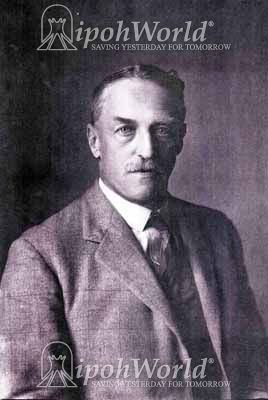Nationality British Role Architect | Name Arthur Hubback Occupation Architect | |
 | ||
Full Name Arthur Benison Hubback (A. B. Hubback) Died May 8, 1948, Broxbourne, United Kingdom | ||
Arthur Benison Hubback (13 April 1871 – 8 May 1948) was an English architect and soldier who designed several important buildings in British Malaya. He was active in sports, especially football and cricket. Hubback was promoted to brigadier general during his service in the British Army.
Contents
- Early life
- Career in architecture
- Military service
- Family
- Buildings
- The significance of Hubbacks work
- Honours
- Sports
- References
Early life
Arthur Hubback was born at 74 Rodney Street, Liverpool, England, son of Joseph Hubback (1814–1882), who was Lord Mayor of Liverpool in 1870 and a merchant, and Georgina (born Eliott-Lockhart). Arthur attended Fettes College, Edinburgh, and then started work as an apprentice for the city architect in Liverpool, Thomas Shelmerdine.
Career in architecture
In 1895, Hubback became chief draughtsman of Selangor public works department, which was then working on the building of government offices now known as Sultan Abdul Samad Building. The Sultan Abdul Samad Building was originally designed by A.C. Norman and R. A. J. Bidwell in a Classic Renaissance style, but Norman's plan was then reworked on by Bidwell in an Indo-Saracenic or Moorish style, and Hubback also worked on the building. After work on the building was finished in 1897, he worked in private practice for a few years, before returning to public work in 1901.
From then until the outbreak of World War I was a period of great construction projects, and he worked on buildings in Malaya and Hong Kong, from mosques to railway stations. An important work designed by Hubback is the Kuala Lumpur railway station. Among other major works he designed are the Jamek Mosque, Kowloon railway station, and Ipoh railway station. He designed at least 25 buildings in Malaya, and many of these are now considered an important part of the architectural heritage of Malaysia.
He returned to England in 1914 and did not design any further buildings in Malaya, although some of his buildings were not completed until later.
Military service
Hubback took charge in the Federated Malay States Volunteer Rifles Force (M.S.V.R.) in 1907. He was appointed as a major in the M.S.V.R. in 1910 and he was in command of F.M.S. Contingent to George V's coronation in 1911. He was then promoted as lieutenant colonel in the M.S.V.R. in 1912.
In 1914, at the start of World War I, he became a major in the 19th battalion, London (territorial) regiment. In 1915, he was the lieutenant colonel commanding the 20th London Regiment Territorial Force, 47th Division B.E.F. He served in France, The Soanne, brigadier of 19th and 20th London Battalion. He became brigadier general of 2nd Infantry Brigade, 1st Division in 1916, and brigadier general commanding of the 63rd Infantry Brigade, 37th Division B.E.F. in 1918. During the war he was mentioned in dispatches six times, and won the CMG and Distinguished Service Order. Following the war he continued in the military, commanding the 5th London infantry brigade of the territorial army from 1920 to 1924.
Family
Hubback married Margaret Rose Frances (Daisy) Voules, the sister of a colleague, in 1901 and they had two children, a son (Arthur Gordon Voules Hubback, R.N.) and a daughter (Yvonne Hubback).
He had two brothers. Theodore Rathbone Hubback joined Arthur in Malaya, and was a civil engineer and contractor, as well as working for a while as a rubber planter, and after early adventures as a big game hunter became a conservationist and author. George Clay Hubback was bishop of Assam and of Calcutta.
He died in Broxbourne, Hertfordshire, on 8 May 1948 of heart failure.
Buildings
Hubback worked on the buildings including:
Source Included From: A.B Hubback: An Architectural Celebration in Malaya Exhibition. Located at National Textile Museum, Kuala Lumpur.
Jointly Organized by PAM Heritage Conservation Committee, Department of Museums Malaysia and National Textile Museum Officially Supported by Masjid Jamek, British Council, Arch, webmaster of thehubbacks.org, midor, ALFO, MIBOUTIQUE and Kuala Lumpur.
The significance of Hubback’s work
Hubback’s architectural work, on the one hand, is rooted in 19th-century eclectic historicism. He took Mughal forms and melded them with Byzantine, Romanesque, and Gothic details to form a ‘new’ kind of architecture known as Indo-Saracenic. The first major work Hubback was involved in, the Sultan Abdul Samad Building, is in this style. It was largely the work by R. A. J. Bidwell following the design direction set by the State Engineer Charles Edwin Spooner, and Hubback made additions and alterations to the building under Spooner's instructions. This strand of English colonial architecture was based on Indian Islamic architecture and not native to Malaya. Hubback and Bidwell effectively introduced into the Malaysian architectural vocabulary the onion dome. His principal building formed the perimeter of the Padang or Merdeka Square, and became a symbol of the colonial administration. The Federal Secretariat/Sultan Abdul Samad Building is as much a part of the architectural consciousness of Malaysia as the Houses of Parliament is to Britain.
The twentieth-century quality of his architectural output is that he created a number of large buildings to house the colonial government's administrative functions, an architectural recognition of the increasing spatial demands of an official bureaucracy, but in elegant dress. While in post-independence Malaysia these functions have moved elsewhere, these buildings remain as a potent visual symbol of the country and its multicultural heritage.
Honours
Sports
Hubback was an active sportsman who played the following sport:
